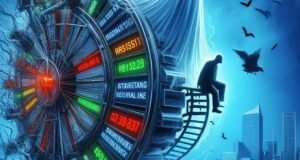Imagine a concert pianist playing a grand performance — each keystroke timed, each note reactive to the audience, each emotion subtly woven into the rhythm. Now imagine if, afterward, the piano itself could whisper to the performer: “You faltered slightly in bar 42, your heart raced before that crescendo, and your left hand hesitated just before the key change.” That is the essence of AI-synced trading journals — instruments that do more than record outcomes. They reflect the trader’s inner world in tandem with performance, offering insight that turns raw behavior into refined mastery.

In the high-octane world of prop trading, this isn’t just innovation — it’s evolution. Because in a game where milliseconds count and psychology bleeds into every execution, a logbook that sees your hands and your head can become the most powerful edge in the room.
1. Beyond the Numbers: Logging the Invisible
Traditional trading journals are graveyards of cold data — entry points, exit times, profit or loss. Useful, yes, but limited. Like a black-and-white security camera, they capture what happened, not why. But what if your journal could also record your mood at entry, your cognitive sharpness during execution, and the shift in your attention span post-loss?
Prop trading desks are now syncing biometric inputs — heart rate variability, EEG-based focus scores, blink frequency — alongside execution metrics. A scalp gone wrong isn’t just logged as a red line but flagged with “reduced alpha-band activity” or “stress spike detected during limit order placement.” The journal becomes a mirror, not just a ledger.
2. The Neural Notepad: Writing Between the Lines
Picture your brain as a cockpit of dials — some controlling reflexes, others emotion, risk tolerance, or fatigue. Now imagine each dial being sampled in real time, and the readings written into your trade log. AI parses this neural metadata, correlating it with your trade performance.
For instance, a trader in a prop trading firm might consistently underperform during trades placed late in the afternoon. The journal highlights that these periods show reduced cognitive coherence — a neural “lag.” The solution isn’t just “don’t trade late” — it’s to optimize the trader’s daily rhythm. The journal gives the feedback, the AI makes it actionable.

3. Pattern Mining at a Deeper Layer
In most firms, trade reviews are weekly rituals. Charts go up, reasons are discussed, decisions are judged. But with AI-synced journals, reviews evolve from “what worked” to “what wore you out.”
- You’re more impulsive after three green trades.
- You misread volatility 70% more when sleep quality scores drop below a threshold.
- Your success rate improves when emotional intensity is medium-high, but drops when it’s extreme.
In prop trading, where performance is the only KPI that matters, such meta-patterns can mean the difference between a 5% return and a 50% one.
4. Real-Time Feedback Loops: Journals That Talk Back
Old journals were dusty archives. AI-synced journals are dynamic coaches. They analyze live trades, whispering nudges like:
- “You’ve placed four trades in 6 minutes. Emotional baseline shows signs of tilt.”
- “Your win rate in this sector improves when you use longer holding periods. Consider shifting strategy.”
- “Prefrontal fatigue detected — switch to model-assisted mode.”
This transforms the journal from a retrospective tool into a co-pilot.
5. Building a Culture of Cognitive Literacy
When prop trading firms integrate AI-synced journals at scale, something fascinating happens: culture shifts. Traders start speaking in a new language — not just of P&L and Sharpe, but of “focus dips,” “reversion heuristics,” and “cognitive drain thresholds.” Peer reviews become richer. Mentorship involves emotional calibration, not just technical critique.
And perhaps most importantly, failure becomes something to understand, not fear. A losing trade isn’t a flaw — it’s a signal, an opportunity to align the inner world with market rhythm.
The Edge Within
The market reveals the truth — but only to those who can decode their own mind. AI-synced trading journals are the stethoscope, the compass, and the black box recorder for the prop trading elite. They transform traders from reactive players into reflective practitioners.
In a future defined by speed and uncertainty, the greatest advantage will belong to those who can see not only the market, but also themselves — clearly, continuously, and with AI sharpening the lens.




